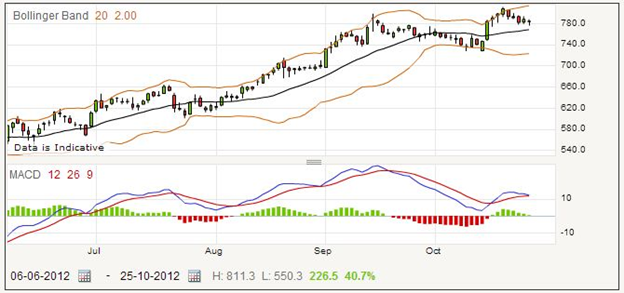Persimmon plc is a house building company which owns several of the best-known names in building in the UK. When spread betting on Persimmon, you must bear in mind that it was hit hard by the subprime mortgage crisis, and the price has never recovered to its previous peak of over 1500. Despite many complaints about workmanship, Persimmon seems to be growing strongly.

The above chart is a recent daily price chart showing substantial activity and an overall uptrend.
The company was founded in 1972, and started in the Yorkshire area. It is headquartered in York, and named after a racehorse from the 19th century. It has expanded greatly by acquisition, and now covers most of the UK, in which is the largest house builder.
In 1984 it purchased Sketchmead, and was floated on the Stock Exchange in 1985, when it was building about 1000 houses a year. In 1995 an aggressive acquisition policy started with Ideal Homes, which strengthened the company’s position in the Southeast of England. Further acquisitions of John Laing and Tilbury Douglas Homes were followed by the purchase of Beazer Homes in 2001, by which time Persimmon was building about 12,000 homes a year. As Beazer already included Charles Church homes in its holdings, Persimmon also gained that premium brand.
Continuing its expansion, Persimmon acquired Westbury in 2006, and Hillreed Homes in 2012. Between these acquisitions, the market was hit hard by the subprime crisis, but Persimmon seems to be pulling out of that.
The chart shows that the shares are fairly volatile, with some longer candles showing larger daily swings in price. Despite the overall upward trend, the chart shows many smaller trends and reversals, making this a difficult share to spread trade. It would be worth looking at charts on different time scales to see whether any of these are more easy to analyze profitably.
Persimmon Rolling Daily: How to Spread Bet on Persimmon shares?
Before placing a spread bet on Persimmon, you need to have done your analysis and decided on your target and possible loss scenarios. Suppose that you find the shares are likely to increase in value, you may be tempted to place a long bet. The current rolling daily price is 783.0 – 787.0, so you could stake £3.50 per point at the buying price of 787.0.
In time, you might find that the shares increase to 847.5 – 851.5, in your target range, and decide to close your spread trade and collect your winnings. The long trade will close at the lower price of 847.5. This means that you have made 847.5-787.0 points, or 60.5 points. With a stake of £3.50 per point that amounts to £211.75 profit. As this was a rolling bet, your account may have been charged a small fee each evening when the bet was rolled over. Usually this does not amount to much.
With the financial markets, you should expect to have your share of losers. Say in this case the price dropped after you placed the bet, you might find that the quote goes down to 729.6 – 733.6 and you need to close your trade to cut your losses. This losing bet would close at 729.6. 787.0 minus 729.6 is 57.4 points, which for your size of bet amounts to £200.90 lost.
Many spread betters decide to use stop loss orders, which cover closing the losing bets for them automatically, even if they are not following the latest market trends. The stoploss order is usually placed when the bet is opened. In this case, a stoploss order might have closed at a price of 742.3 – 746.3. The loss in this case is 787.0 less 742.3, which is 44.7 points. This works out to a cost of £156.45.
Persimmon Futures Based Spread Bet
Unlike the rolling bet, the futures bet has no ongoing cost while it is held open, so it can work out cheaper for trades which you think may take a while to resolve. The far quarter spread bet on Persimmon is priced at 785.3 – 794.8. With a long-term bullish view point, you decide to stake £8.50 per point.
For the sake of example, imagine that the price goes up to 876.9 – 885.4. You can close the bet and count up your winnings. The opening price of the spread bet was 794.8. The closing price was 876.9. That means you have gained 876.9 minus 794.8 points, which is 82.1 points. Multiplying by £8.50, your total winnings are £697.85.
Looking now at the other outcome, you might find that the price falls after you place the bet, and you decide to close the bet to cut your losses when the quote is 723.6 – 731.9. The opening price was 794.8, as before. This time the closing price is 723.6. The difference between these is 71.2 points. For your wager of £8.50 per point, this amounts to a loss of £605.20.
It is easy to let losses run away with you, particularly if you do not have time to watch the price all day. That is when a stoploss order is useful, closing a losing spread trade for you if the price you set is reached. In this case, you might have saved some of your loss by taking out a stop loss order when you placed the bet. Once triggered, the stoploss order closes the trade at the market price, say in this case 752.1 – 760.9. You work out how much you have lost in the same way as before. The opening price was 794.8, and the spread trade closed at 752.1. The difference between these is 42.7 points, and multiplying by £8.50 you would have lost £362.95 this time.